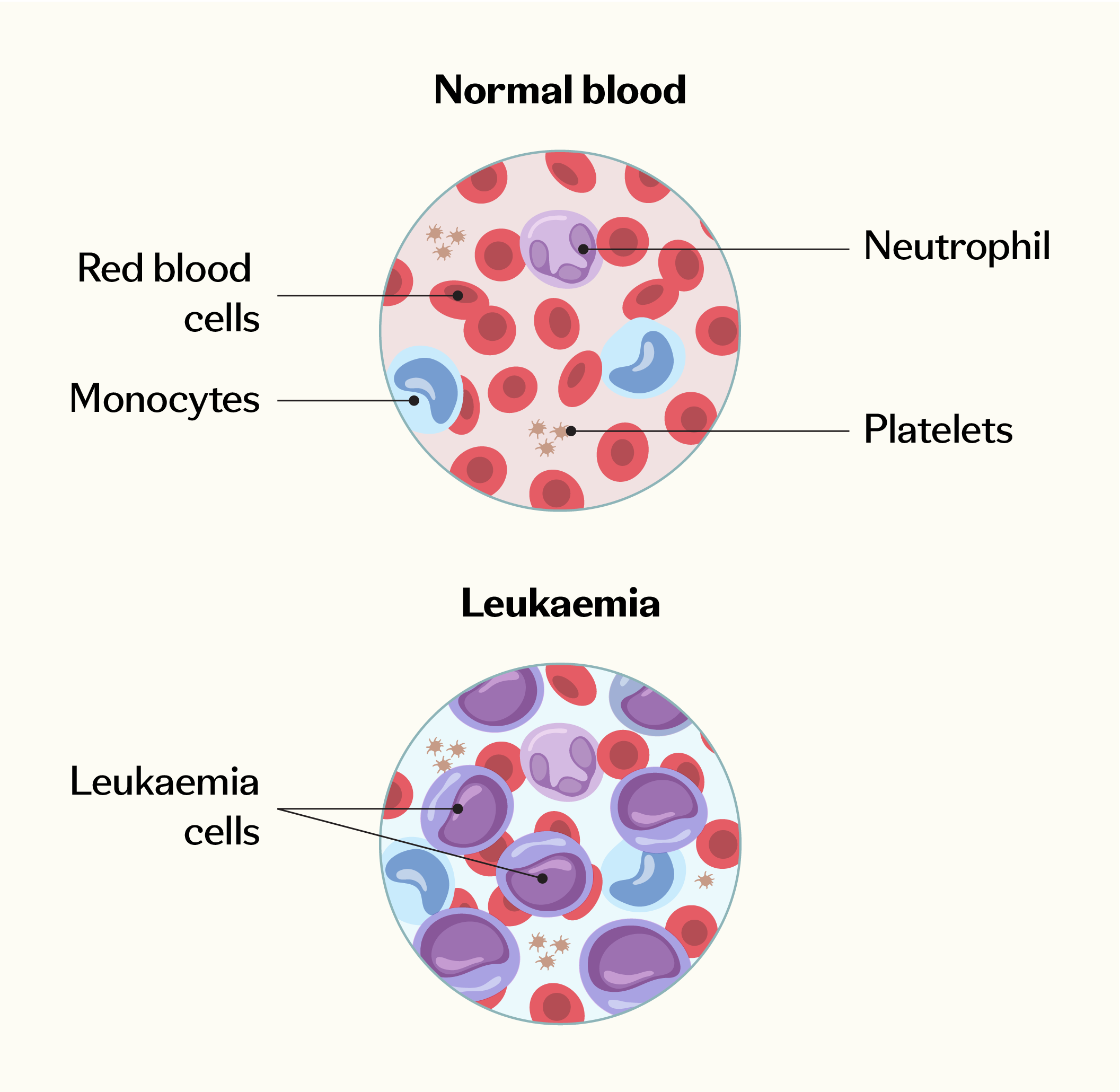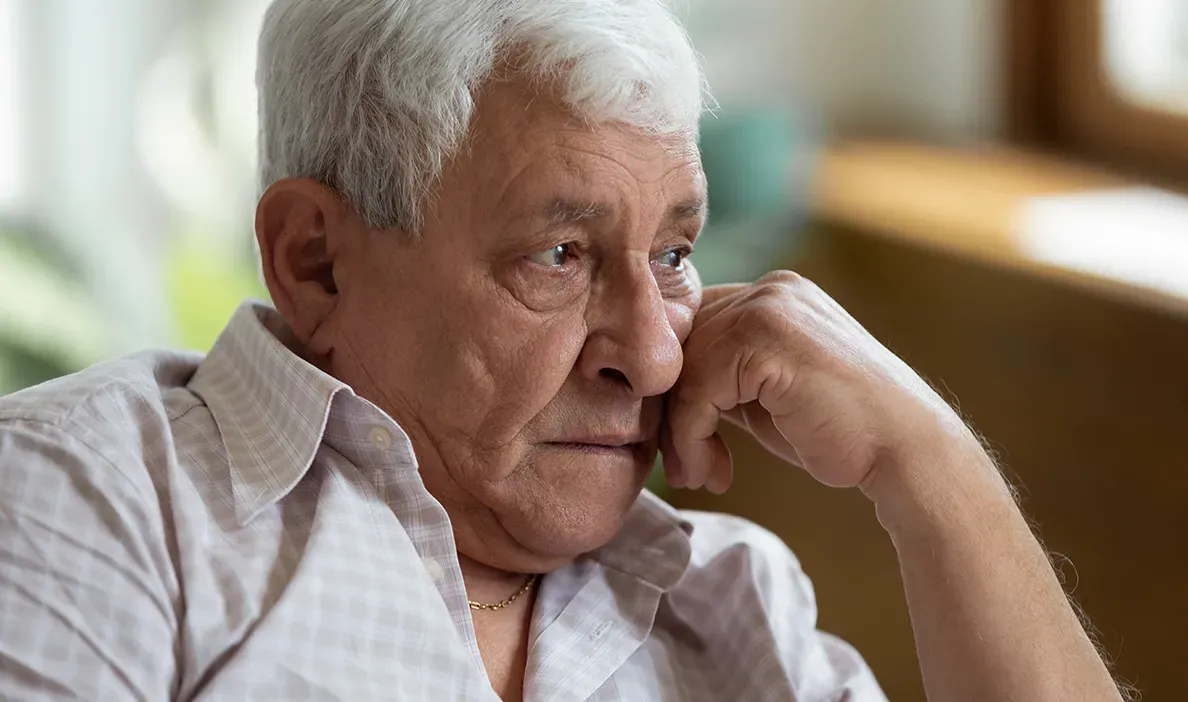How leukaemia starts
Leukaemia is a type of blood cancer. It starts in blood cells found in the middle part of our bones, called the bone marrow.1,2

When someone has leukaemia, abnormal blood cells are made. They grow out of control and make it difficult for healthy blood cells to be made.3
In the UK, there are around 10,000 people diagnosed with leukaemia each year.*4
It’s not always clear what causes leukaemia, but there are certain factors that increase someone’s risk of getting it. These include being a certain age and coming into contact with radiation, chemotherapy or chemicals.5,6,7,8
*Estimate based on the average number of people diagnosed with leukaemia in the UK each year between 2017 and 2019.
Types of leukaemia
There are different types of leukaemia. These are based on which type of blood cell is affected and whether the leukaemia grows quickly or slowly. The main types are:2,9
This affects a type of immune cell called myeloid stem cells. Symptoms tend to come on quite quickly and people usually need treatment quite quickly.2
This affects a type of immune cell called lymphoid stem cells. Symptoms tend to come on quite quickly and people usually need treatment quite quickly.2
This is the most common type of leukaemia. It develops slowly and tends to not cause symptoms at the start. Like ALL, it affects lymphoid stem cells.2
Like AML, this affects myeloid stem cells. It develops slowly and tends to not cause symptoms early on.2
Treatment options for leukaemia
The exact treatment given to someone with leukaemia depends on a few things, including which type of leukaemia they have. For example, acute leukaemia is fast-growing and often needs to be treated quickly. Other factors, such as the person’s age and general health, will also play a role.2,10
Common treatments for leukaemia include:1
- Chemotherapy: this uses drugs to kill the cancer cells or to slow their growth. It tends to be given to people with acute leukaemia2
- Targeted therapy: these are medicines that target the changes in cancer cells that allow them to grow and survive in the body
- Stem cell transplants: this involves giving someone healthy stem cells to replace the blood cells that are affected by leukaemia
- Active monitoring (also known as ‘watch and wait’): if you have a slow-growing type of leukaemia, you might not need treatment straight away. Instead, your healthcare team might keep a close eye on the cancer until it's ready for treatment
Your treatment plan will be specific to you. It’s important to speak with your healthcare team to fully understand your options and what to expect from your treatment.
Remember that support is available and you’re not alone in this.

If you or someone you know has been diagnosed with cancer, support groups and charities are great places to find information and connect with people going through a similar experience.

Life with cancer is different for everyone. So, if you need support, it should be personal to you. ByYourSide has been created by Pfizer to offer you practical support and guidance to help you manage life with cancer in a way that is best for you.
References
- Blood Cancer UK. Leukaemia. Available from: https://bloodcancer.org.uk/understanding-blood-cancer/leukaemia/ [Accessed May 2025].
- Macmillan. Leukaemia. Available from: https://www.macmillan.org.uk/cancer-information-and-support/leukaemia [Accessed May 2025].
- Cleveland Clinic. Leukaemia. Available from: https://my.clevelandclinic.org/health/diseases/4365-leukemia [Accessed May 2025].
- Cancer Research UK. Leukaemia (all subtypes combined) statistics. Available from: https://www.cancerresearchuk.org/health-professional/cancer-statistics/statistics-by-cancer-type/leukaemia [Accessed May 2025].
- NHS. Acute myeloid leukaemia: causes. Available from: https://www.nhs.uk/conditions/acute-myeloid-leukaemia/causes/ [Accessed May 2025].
- NHS. Acute lymphoblastic leukaemia: causes. Available from: https://www.nhs.uk/conditions/acute-myeloid-leukaemia/causes/ [Accessed May 2025].
- NHS. Chronic lymphocytic leukaemia: causes. Available from: https://www.nhs.uk/conditions/chronic-lymphocytic-leukaemia/causes/ [Accessed May 2025].
- NHS. Causes of chronic myeloid leukaemia. Available from: https://www.nhs.uk/conditions/chronic-myeloid-leukaemia/causes/ [Accessed May 2025].
- Anthony Nolan. What is blood cancer? Available from: https://www.anthonynolan.org/patients-and-families/blood-cancers-and-blood-disorders/what-is-blood-cancer [Accessed May 2025].
- Leukaemia UK. Treatment for leukaemia. Available from: https://www.leukaemiauk.org.uk/about-leukaemia/treatments-2/ [Accessed May 2025].
